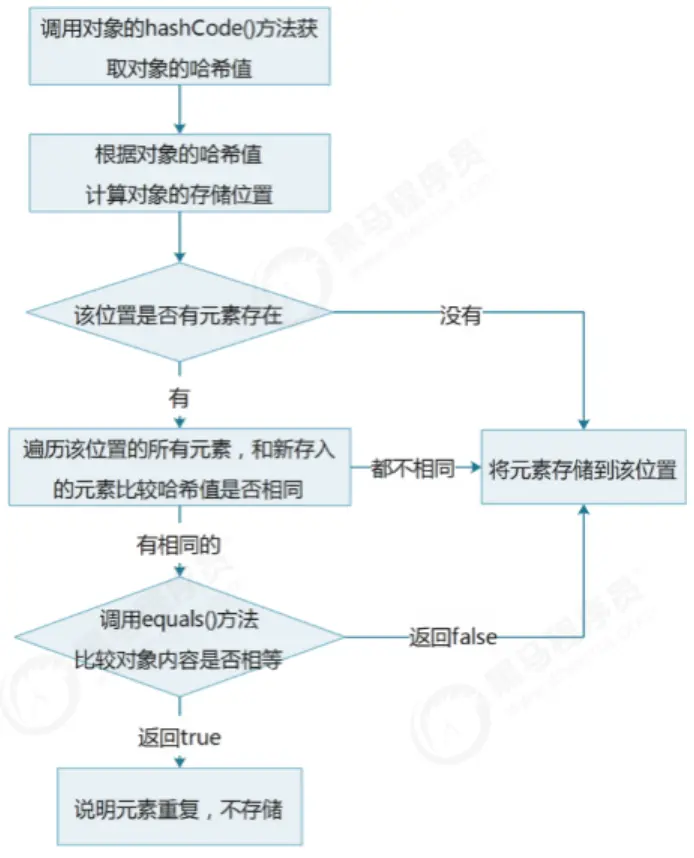 set集合
set集合
# 1 Set集合概述和特点
- Set集合的特点
- 元素存取无序
- 没有索引、只能通过迭代器或增强for循环遍历
- 不能存储重复元素
# 2 Java哈希值
- 哈希值简介
- 是JDK根据对象的地址或者字符串或者数字算出来的int类型的数值
- 如何获取哈希值
- Object类中的 public int hashCode():返回对象的哈希码值
- 哈希值的特点
- 同一个对象多次调用 hashCode() 方法,返回的哈希值是相同的
- 默认情况下,不同对象的哈希值是不同的。而重写hashCode()方法,可以实现让不同对象的哈希值相同
# 3 HashSet集合概述和特点
HashSet集合的特点
底层数据结构是哈希表
对集合的迭代顺序不作任何保证,也就是说不保证存储和取出的元素顺序一致
没有带索引的方法,所以不能使用普通for循环遍历
由于是Set集合,所以是不包含重复元素的集合
HashSet存储逻辑:

案例需求
- 创建一个存储学生对象的集合,存储多个学生对象,使用程序实现在控制台遍历该集合
- 要求:学生对象的成员变量值相同,我们就认为是同一个对象
学生类:
public class Student {
private String name;
private int age;
public Student() {
}
public Student(String name, int age) {
this.name = name;
this.age = age;
}
public String getName() {
return name;
}
public void setName(String name) {
this.name = name;
}
public int getAge() {
return age;
}
public void setAge(int age) {
this.age = age;
}
@Override
public boolean equals(Object o) {
if (this == o)
return true;
if (o == null || getClass() != o.getClass())
return false;
Student student = (Student) o;
if (age != student.age)
return false;
return name != null ? name.equals(student.name) : student.name == null;
}
@Override
public int hashCode() {
int result = name != null ? name.hashCode() : 0;
result = 31 * result + age;
return result;
}
}
1
2
3
4
5
6
7
8
9
10
11
12
13
14
15
16
17
18
19
20
21
22
23
24
25
26
27
28
29
30
31
32
33
34
35
36
37
38
39
2
3
4
5
6
7
8
9
10
11
12
13
14
15
16
17
18
19
20
21
22
23
24
25
26
27
28
29
30
31
32
33
34
35
36
37
38
39
- 测试类
public class HashSetDemo {
public static void main(String[] args) {
//创建HashSet集合对象
HashSet<Student> hs = new HashSet<Student>();
//创建学生对象
Student s1 = new Student("林青霞", 30);
Student s2 = new Student("张曼玉", 35);
Student s3 = new Student("王祖贤", 33);
Student s4 = new Student("王祖贤", 33);
Student s5 = new Student("", 33);
Student s6 = new Student("", 33);
//把学生添加到集合
hs.add(s1);
hs.add(s2);
hs.add(s3);
hs.add(s4);
hs.add(s5);
hs.add(s6);
hs.add(new Student());
hs.add(new Student());
//遍历集合(增强for)
for (Student s : hs) {
System.out.println(s.getName() + "," + s.getAge());
}
}
}
1
2
3
4
5
6
7
8
9
10
11
12
13
14
15
16
17
18
19
20
21
22
23
24
25
26
2
3
4
5
6
7
8
9
10
11
12
13
14
15
16
17
18
19
20
21
22
23
24
25
26
# 4 LinkedHashSet集合概述和特点
LinkedHashSet集合特点
- 哈希表和链表实现的Set接口,具有可预测的迭代次序
- 由链表保证元素有序,也就是说元素的存储和取出顺序是一致的
- 由哈希表保证元素唯一,也就是说没有重复的元素
测试类
public class LinkedHashSetDemo {
public static void main(String[] args) {
//创建集合对象
LinkedHashSet<String> linkedHashSet = new LinkedHashSet<String>();
//添加元素
linkedHashSet.add("hello");
linkedHashSet.add("world");
linkedHashSet.add("java");
linkedHashSet.add("world");
//遍历集合
for(String s : linkedHashSet) {
System.out.println(s);
}
}
}
1
2
3
4
5
6
7
8
9
10
11
12
13
14
15
2
3
4
5
6
7
8
9
10
11
12
13
14
15
# 5 TreeSet集合概述和特点
TreeSet集合概述
- 元素有序,可以按照一定的规则进行排序,具体排序方式取决于构造方法
- TreeSet(Comparator comparator) :根据指定的比较器进行排序
- TreeSet():根据其元素的自然排序进行排序
- 没有带索引的方法,所以不能使用普通for循环遍历
- 由于是Set集合,所以不包含重复元素的集合
- 元素有序,可以按照一定的规则进行排序,具体排序方式取决于构造方法
案例需求
- 存储学生对象并遍历
- 要求:按照年龄从小到大排序,年龄相同时,按照姓名的字母顺序排序
# 5.1 比较器排序Comparator
public class TreeSetDemo {
public static void main(String[] args) {
// 创建集合对象
TreeSet<Student> ts = new TreeSet<Student>(new Comparator<Student>() {
@Override
public int compare(Student o1, Student o2) {
int num = o1.getAge() - o2.getAge();
int num2 = num == 0 ? o1.getName().compareTo(o2.getName()) : num;
return num2;
}
});
//把学生添加到集合
ts.add(new Student("xishi", 29));
ts.add(new Student("wangzhaojun", 28));
ts.add(new Student("diaochan", 30));
ts.add(new Student("yangyuhuan", 33));
ts.add(new Student("linqingxia",33));
ts.add(new Student("linqingxia",33));
//遍历集合
for (Student s : ts) {
System.out.println(s.getName() + "," + s.getAge());
}
}
}
1
2
3
4
5
6
7
8
9
10
11
12
13
14
15
16
17
18
19
20
21
22
23
24
25
26
2
3
4
5
6
7
8
9
10
11
12
13
14
15
16
17
18
19
20
21
22
23
24
25
26
# 5.2 自然排序Comparable
- 学生类
public class Student2 implements Comparable<Student2> {
private String name;
private int age;
public Student2() {
}
public Student2(String name, int age) {
this.name = name;
this.age = age;
}
public String getName() {
return name;
}
public void setName(String name) {
this.name = name;
}
public int getAge() {
return age;
}
public void setAge(int age) {
this.age = age;
}
@Override
public int compareTo(Student2 student2) {
int num = this.getAge() - student2.getAge();
int num2 = num == 0 ? this.getName().compareTo(student2.getName()): num;
return num2;
}
}
1
2
3
4
5
6
7
8
9
10
11
12
13
14
15
16
17
18
19
20
21
22
23
24
25
26
27
28
2
3
4
5
6
7
8
9
10
11
12
13
14
15
16
17
18
19
20
21
22
23
24
25
26
27
28
- 测试类
public class TreeSetDemo2 {
public static void main(String[] args) {
//创建集合对象
TreeSet<Student2> ts = new TreeSet<Student2>();
//把学生添加到集合
ts.add(new Student2("xishi", 29));
ts.add(new Student2("wangzhaojun", 28));
ts.add(new Student2("diaochan", 30));
ts.add(new Student2("yangyuhuan", 33));
ts.add(new Student2("linqingxia",33));
ts.add(new Student2("linqingxia",33));
//遍历集合
for (Student2 s : ts) {
System.out.println(s.getName() + "," + s.getAge());
}
}
}
1
2
3
4
5
6
7
8
9
10
11
12
13
14
15
16
17
2
3
4
5
6
7
8
9
10
11
12
13
14
15
16
17
编辑 (opens new window)
上次更新: 2023/04/09, 11:59:04
